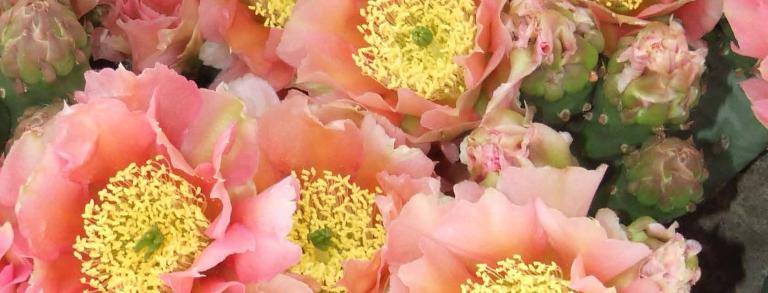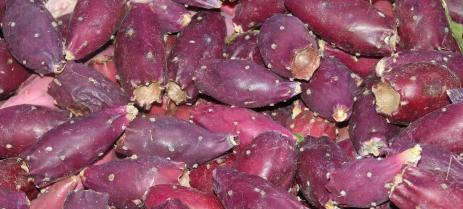OPUNTIA, COMMONLY KNOWN as prickly pear, is a large genus encompassing many species, most of which are native to the deserts of western North America. We residents of the West often take prickly pears for granted: stepping over and walking around them while hiking, hunting, or sightseeing. They may command a little more respect when a hiker comes across an opuntia in flower. The silky, colorful blossoms are stunning and often trembling with visiting pollinators.
Gradually, opuntias are finding favor in gardens not only in the western United States but also in the Midwest, South, and East. As opuntia is only native in the Americas, they seem very exotic to plant collectors in other continents. There are numerous cactus nurseries in Europe. Demand for nursery-grown and wild-collected cacti and other succulents has escalated due to the fervor created by garden and interior designers who utilize these amazing plants. As water costs sharply increase and our sense of sustainable living and gardening increases, the demand for these low-water plants has exploded. The aesthetic hump of utilizing prickly plants in the garden has diminished. With the trend to urban agriculture, edible varieties of opuntia are becoming popular.
In our nursery we went from selling a handful of outdoor cactus a year to over 800 #1-sized plants in 2015. We wholesaled more than 3000 #1-size (and larger) cactus plants to other retailers in 2015, and the demand has grown.
The demand for opuntia in the garden market is largely due to their highly ornamental aspects. Many varieties are beautiful structurally, and their flowers are spectacular. Most have significant winter interest. Opuntias offer a low-water substitute for garden flower groups like roses, camellias, and peonies. Now, with selections and hybrids that have few or no spines the nursery offerings of opuntia are more palatable to the average gardener. As happened with roses and other flower groups, cultivar selection among opuntias is growing rapidly. Several Western nurseries offer beautiful varieties both wholesale and retail.
Social media hosts many cactus collector and information groups. Memberships in cactus and succulent clubs and societies have increased dramatically. Online cactus retailers are making it easy for everyone to have cacti in their home and garden. The biggest challenge to the online and conventional retailers and wholesalers is that the plant family Cactaceae is listed in The Convention on International Trade in Endangered Species (CITES), which is an international agreement to protect threatened and endangered species of both flora and fauna. Since the whole Cactaceae family is listed in CITES, it is technically illegal to ship cacti from their native lands to other countries. An update to the agreement recently clarifies that propagules such as stems, pads, tissue cultured plants still in sealed media vessels and certain species can be traded internationally as they do not pose a risk to wild populations.
I still remember the delicate, citrusy fragrance of the opuntia and coryphantha flowers that poked through the buffalo grass at our family’s ranch in the Black Hills of South Dakota. I was five or six years old. I was hooked. After decades of overgrazing, the weakened grass gave way to opuntia. Every few years, Dad or Uncle would drag an I-beam or logging chain behind the ’53 farm tractor in an effort to eradicate the prickly pests. It was thought this would give the buffalo grass a chance to recover. In reality, we just had too many sheep. Wool was our crop in this dry, dusty land. In mid-March, usually, we’d shear the ewes. We little folks climbed into the enormous burlap sacks hanging from a steel rack and stomped the mixture of oily wool and bloated ticks firmly in the tube until it could hold no more. Our wool didn’t bring a high price because it was stained red from the clay soil, as was the truck, the sheets, and Grandma’s crystal.
The ground-hugging northern opuntia species O. polyacantha, O. cymochila, and O. fragilis all sport rather bland yellow flowers in mid- to-late June. Occasionally, I’d come across the scarce Opuntia macrorhiza with its tasty red fruit. The fruit, even carefully peeled with a pocket knife always left an annoying glochid in the tip of the tongue, but it was worth it. The little native mice would bypass the sweet red flesh and cache the big, nutritious seeds.
In 1986 after graduating from Colorado State University with my degree in horticulture, I was working at a retail nursery in Denver. Before long, I met the Opuntia Queen of the region: Mary Ann Heacock. We traveled the plains and mountains seeking out the region’s numerous cactus species. We discovered numerous plants worthy of friendly cultivar names: ‘Pawnee’s Green Rose’, ‘Wavy Gravy’, ‘Peter Pan’ and many more. Opuntia heacockiae was named after this great prickly pear pioneer.
Mary Ann had a significant number of Claude Barr’s collection of opuntias. Claude was one of the first horticulturists to focus on the hardy native plants of the northern plains. His opuntias would offer genes of resilience, hardiness, and flower qualities to my later hybrids.
In 2005 I obtained many new species from the Grand Junction, Colorado, cactus garden located at the county extension office. Their curator, cactiphile Don Campbell, was very generous in sharing the clones. By then I had well over one hundred selections of opuntia. The garden hybrid Opuntia ‘Dazzler’ (O. schweriniana x O. basilaris) introduced by Leo Chance of Colorado Springs, Colorado, inspired me to pursue the possibility of creating hybrids. Recently, amazing hybrids are coming from plantsman Jeff Thompson in Pueblo, Colorado. Many other excellent clonal selections provided pollen for my crosses.
The turning point in my collection (which led to new hybrids) was when I found a humble, small padded O. aurea near Silver Reef, Utah. After a few seasons of growing this beauty in the rock garden, I realized it virtually bloomed all summer. I called it ‘Golden Carpet’. Hybrids created with this gorgeous plant became what I branded Walk in BeautyTM hybrids. As the collections in cactus nurseries increase, so do the new cultivar selections that are significantly more garden worthy.


